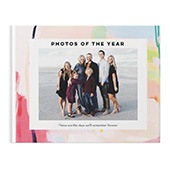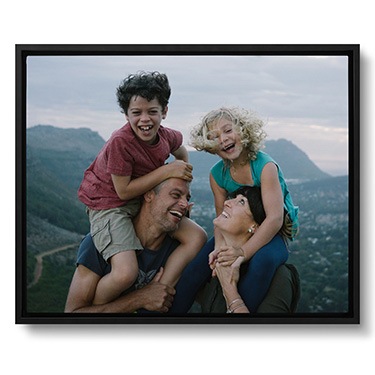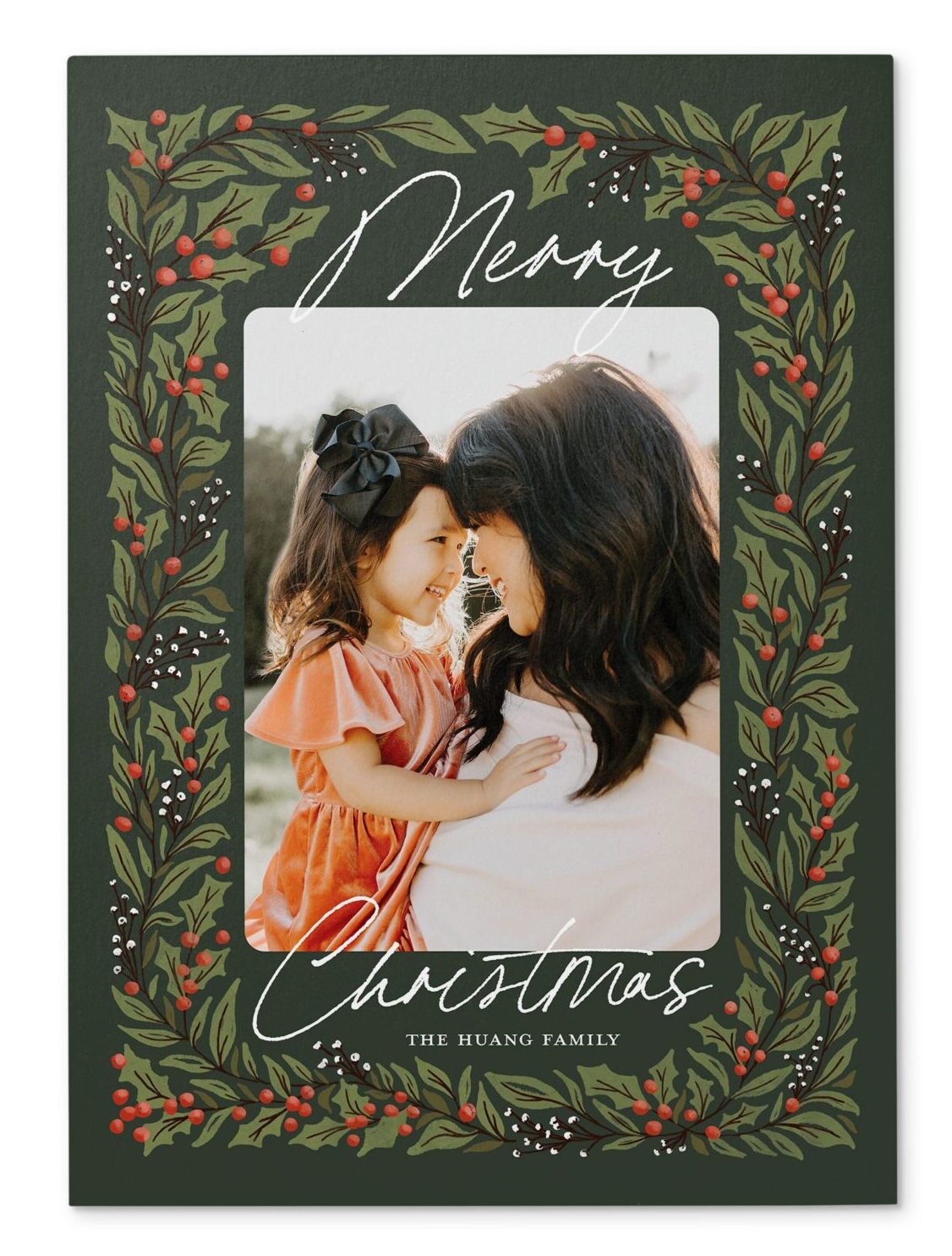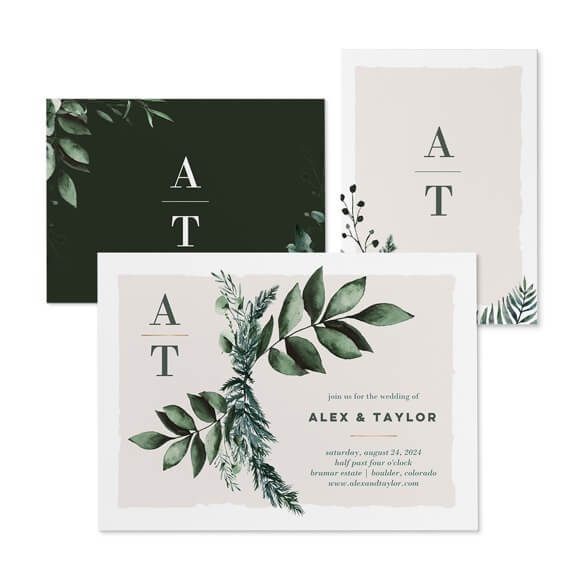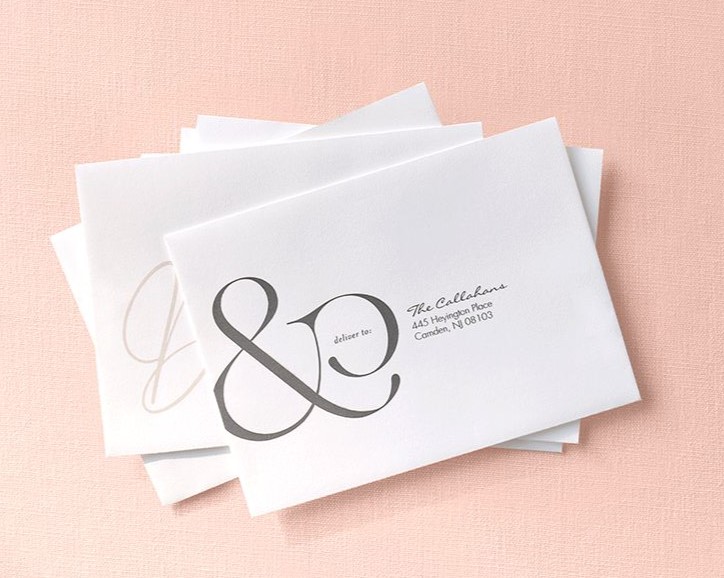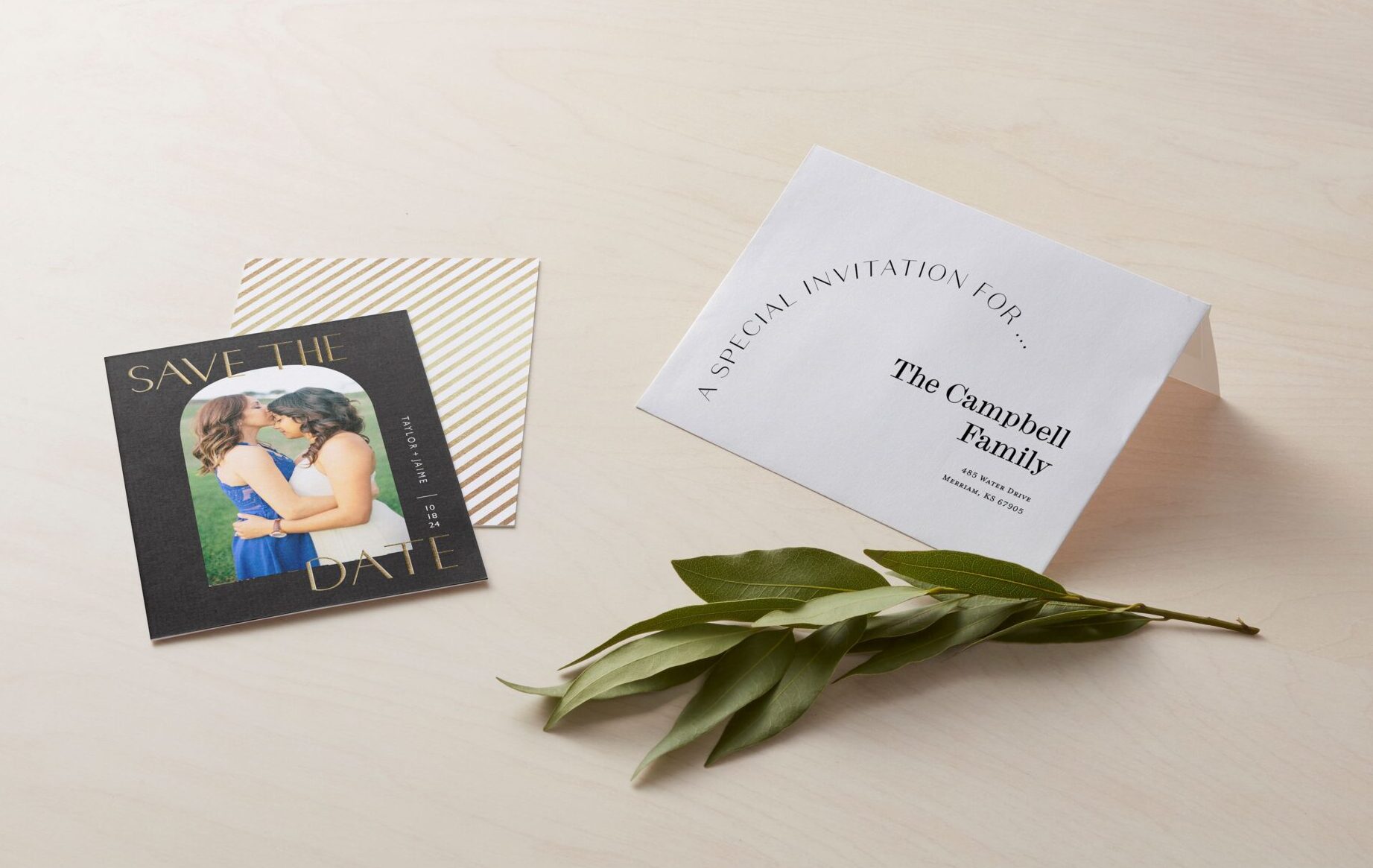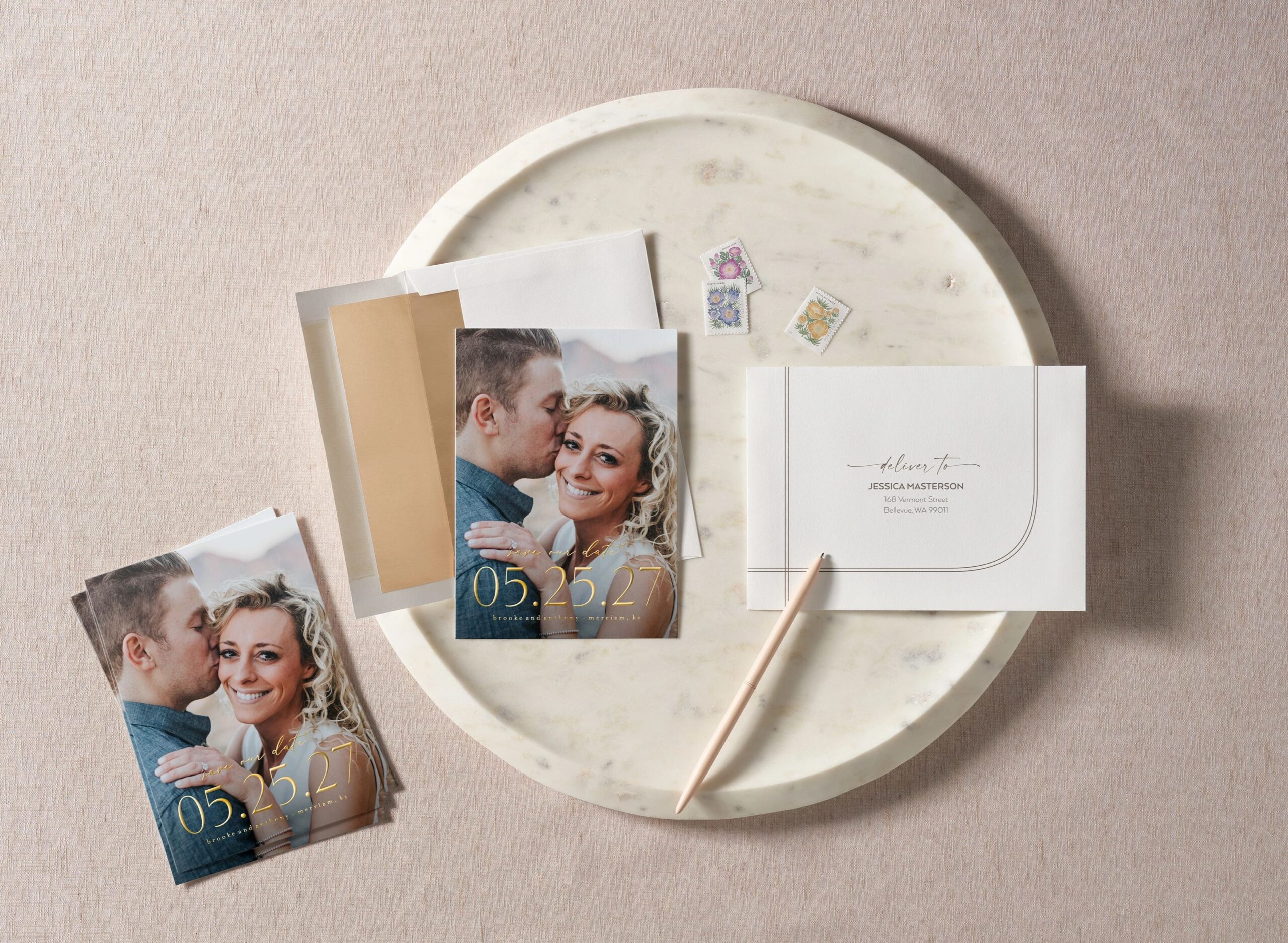Understanding Wedding Invitation Etiquette
The way you address wedding invitations plays a significant role in setting the tone for your celebration. Properly addressed invitations show your attention to detail and respect for your guests. Whether you’re following traditional conventions or modern preferences, knowing how to formally address wedding invitations can create a personal touch that resonates with your guests.
Common mistakes to avoid include misaddressing or spelling names incorrectly. Double-check your guest list to ensure accuracy. Including important details such as plus-ones or children is crucial to avoid confusion. Make sure to address invitations to the specific individuals invited, ensuring everyone knows who is welcome to attend. By understanding these etiquette principles, you can ensure your wedding invitations are inviting and respectful, setting the stage for an unforgettable celebration.
How to Address Wedding Invitation Envelopes
1. Gather Your Supplies
Before diving in, make sure you have all the essentials:
- Your guest list with correct names and addresses. Request any you don’t have with Shutterfly’s free address book service.
- Your beautifully printed wedding invitations and envelopes
- A high-quality pen or calligraphy tools
- Optional: return address labels or personalized address stamps
2. Use Proper Titles
When addressing your wedding invitations, formal titles are a must. Here’s a quick overview of how to address different guests:
- Married Couple: Use “Mr. and Mrs.” followed by the husband’s full name (e.g., Mr. and Mrs. John Smith). For same-sex couples or if the couple prefers both names, write each full name on the same line (e.g., Mr. John Smith and Mr. Michael Brown).
- Unmarried Couple: List each guest’s full name on separate lines, starting with the name of the person you’re closest to (e.g., Ms. Emily Johnson and Mr. Daniel Wright).
- Single Guest with a Plus-One: Address the invitation to the guest’s full name and include “and Guest” (e.g., Ms. Sarah Brown and Guest).
- Families with Children: Write the parents’ names on the first line and the children’s first names underneath (e.g., Mr. and Mrs. Alex Lee, followed by Emma, Oliver, and Henry).
3. Double-Check Your Guest List
Accuracy is key when addressing your envelopes. Double-check spelling, titles, and addresses before getting started to avoid any errors. Make sure to confirm any recent address changes and use the correct ZIP code.
4. Address the Envelope
Your wedding invitation envelope should be addressed in a formal manner using titles and full names. Here’s an example for a married couple:
Mr. and Mrs. John Smith
1234 Maple Street
San Francisco, CA 94122
For single guests or unmarried couples, follow the appropriate format we discussed earlier. Always use full names and avoid nicknames on the envelope.
5. Return Address Etiquette
Including your return address is important in case invitations get lost in the mail or need to be returned. The return address usually goes on the back flap of the outer envelope. You can handwrite it, but using a personalized return address stamp or printed address labels is a stylish and easy option. For wedding invitations, it’s traditional to use the address of the person hosting the wedding—whether it’s the couple or a parent.
6. Send Invitations Early
Wedding invitations should be mailed out six to eight weeks before your big day. For destination weddings, aim to send them about three months in advance to give guests extra time to make travel arrangements. This timeline ensures that everyone has plenty of time to RSVP and mark their calendars.
7. Have Fun and Celebrate This Special Moment!
Addressing wedding invitations may seem like a small task, but it’s a milestone in your wedding planning that marks the beginning of your celebration. Take a moment to enjoy the process—after all, it’s one step closer to your big day! If you make a mistake, don’t worry—have a few extra envelopes on hand, or reach out to Shutterfly for help with personalized envelopes and addressing options.
Addressing Wedding Invitations Envelope Examples
When it comes to addressing your wedding invitations, different circumstances call for different approaches. Whether you’re inviting families, couples, or single guests, the way you address the envelope should reflect the recipient’s situation. Below are some common scenarios and examples to guide you.
1. Married Couple (Same Last Name)
For a married couple who share the same last name, use both titles and the shared last name.
Example:
Mr. and Mrs. John Smith
2. Married Couple (Different Last Names)
If the couple is married but has different last names, list both full names on the envelope.
Example:
Mr. John Smith and Mrs. Emily Davis
3. Unmarried Couple Living Together
For an unmarried couple living together, list both names on the envelope. Put the person you know best first, or list alphabetically if you’re close to both.
Example:
Ms. Sarah Taylor and Mr. Michael Anderson
4. Single Guest with a Plus One
When inviting a single guest with the option of bringing a guest, use “and Guest” after their name.
Example:
Ms. Jessica Brown and Guest
5. Single Guest (No Plus One)
If the guest is single and not bringing a plus one, address the invitation to them alone.
Example:
Mr. Daniel Lee
6. Family with Children (Under 18)
When inviting a family with young children, list the parents’ names on the envelope. You can either include “and Family” to indicate the children are invited, or specify “The Wilson Family.”
Examples:
Mr. and Mrs. James Wilson and Family
or
The Wilson Family
7. Family with Children (Over 18)
If children over 18 are invited, send them their own separate invitation.
Example:
Mr. Alex Wilson
8. Divorced Woman (Using Maiden Name)
For a divorced woman who has reverted to her maiden name, address her as “Ms.” followed by her full name.
Example:
Ms. Katherine Moore
9. Divorced Woman (Using Married Name)
If a divorced woman still uses her married last name, address her as “Ms.” followed by her married name.
Example:
Ms. Katherine Johnson
10. Widowed Woman
Traditionally, a widowed woman can be addressed using “Mrs.” followed by her late husband’s name, though you can also use her first name if you know she prefers it.
Examples:
Mrs. William Thompson
or
Mrs. Rachel Thompson
FAQs About Addressing Wedding Invitations
To help make the process even smoother, we’ve gathered some frequently asked questions about addressing wedding invitations. Whether you’re unsure about titles or how to include plus-ones, this section has you covered.
Does Shutterfly offer envelope addressing?
Yes! Shutterfly provides envelope addressing services to make your wedding planning easier. You can choose from a variety of stylish fonts and designs to match your invitations, and Shutterfly will print your guests’ addresses directly on the envelopes. This service saves you time and ensures your invitations look professional and cohesive.
Do I need to include a return address?
Yes, including a return address is important in case the invitation needs to be returned for any reason. Place the return address on the back flap of the envelope. Using a return address stamp or custom address labels can make this process quicker and easier.
How do I address a wedding invitation to a doctor?
When addressing a doctor, use their full title. For a married couple where one is a doctor, the doctor’s name should be listed first:
Dr. and Mrs. John Smith
If both are doctors, list them as:
The Doctors Smith
For unmarried couples where only one is a doctor, list their full names on separate lines:
Dr. Emily Johnson
Mr. Michael Brown
What’s the difference between Miss and Ms. when addressing envelopes?
Traditionally, “Miss” is used for unmarried women, typically those who are younger, while “Ms.” can be used for any woman regardless of marital status. “Ms.” is a more modern and neutral title that’s appropriate for both married and unmarried women, especially if you’re unsure of their preference. To avoid assumptions, “Ms.” is often the safest choice.
What if I don’t know the guest’s plus-one’s name?
If you’re allowing a plus-one but don’t know their name, address the envelope to your guest and include “and Guest”:
Ms. Sarah Brown and Guest
You can also specify on the RSVP card for them to include their plus-one’s name.
Should I handwrite or print the addresses?
For a more personal touch, handwritten addresses are preferred. However, if you’re short on time or want a more uniform look, Shutterfly offers free options for printing addresses directly on the envelopes to save time and ensure accuracy.
Do I still have to make wedding invitations formal if the wedding is casual?
While your wedding may be casual, it’s still best to keep your invitations somewhat formal. The wording on the invitation can reflect the relaxed nature of the event, but addressing the envelopes with proper titles (like Mr., Mrs., or Ms.) shows respect and appreciation for your guests. It strikes the perfect balance between casual and thoughtful.
Related Resources on Wedding Invitations
Addressing your wedding invitations doesn’t have to be a stressful part of the planning process. With a little attention to detail and the proper etiquette, you’ll ensure that your guests feel honored and appreciated before they even open the envelope. Whether you’re addressing couples, families, or single guests, following these guidelines will help you navigate the process smoothly.
Now that you’ve mastered how to address your invitations, you can focus on other exciting aspects of your big day—knowing your invitations will arrive with care and consideration.
Additional Resources:
